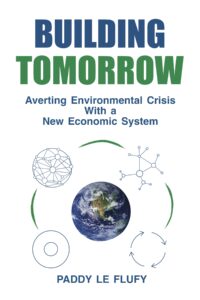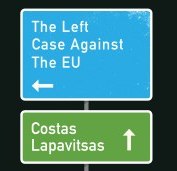
Book Review by Manda Scott
We’re in the midst of a polycrisis. If generalised, unaligned AI doesn’t terminate us, the oceans seem likely to die before we do, and if we manage to survive both, we’ll run out of materials to build anything, so the shift to a carbon-free economy seems as far away as ever. Add in the real-time disintegration of our democracy, the collapse of the capitalist model, and soaring levels of social inequity both within and between nations, and life looks pretty grim.
In all of this, therefore, it’s rather heartening to have a book that explores grounded and practical ways to shift the paradigm from the old extractivist model that is destroying us, to something genuinely regenerative. ‘Building Tomorrow’ by Paddy Le Flufy does exactly this. Nothing in here is radical or likely to scare the horses. It isn’t advocating total systemic change overnight, but rather, it brings together a wide range of ideas that have been floating in the regenerative space for a while and weaves them into a single coherent narrative that feels as if it could actually work.
Built around six ‘organisational technologies’, the book clearly presents the need for a better economic system, looking at what existing technologies we need to replace and then, suggests two existing models that would function well together and would transform the value systems by which we currently work.
First up in this road to recovery is the Doughnut Economic model created by Kate Raworth (who had better get the Prize for Economic Sciences for this pretty soon, or there’s no justice in the world). This proposes that our economy must move from ignoring ‘externalities’ in our endless press for growth, to a system that is regenerative by design: that ‘meets the needs of all people within the means of the living planet’. Clearly to achieve this, we need to define both the needs and the means and the Doughnut does this by setting a floor bases on fundamental human rights to things like education, health, nutrition, genuine democratic choice, and then creating a ceiling of the planetary boundaries as defined by the Stockholm Resilience Centre. The space within these, if expressed as a torus, is the ‘Doughnut’ of safe human living. Having explained this in straightforward terms, what Le Flufy does is to combine it with the concept of a Circular Economy where the output of one manufacturing process becomes the input stream to another and everything is designed to be re-used. Having watched this concept being used as greenwashing over the past decade or so, I’m absolutely certain it’s the way forward, but equally certain that it’s not going to happen while the growth imperative is embedded into the DNA of the entire business community.
I’m pretty sure Paddy feels this too – because the third of the six transformational technologies is the ‘Future Guardian’ model of business governance. This is where the book became genuinely exciting. The Future Guardian model was developed by Riversimple, a company in Wales that is developing hydrogen fuel cell cars. I’m sure the cars are interesting, but their approach to changing the business model is what will be talked about by our descendants for the next several hundred generations – if it takes off. Put simply, Riversimple is no longer dedicated simply to feeding the giant vampire squid wrapped around the face of humanity. It doesn’t just have ‘shareholder value’ as its prime directive – six separate stakeholders are named in its Articles of Association: the Environment, the Customers, the Employees, the Local Community, the Commercial Partners (aka the supply chain) and the Investors.
Each of these counts equally. Each has a voice. Every decision is made with all six in mind. And this is something that could be done by any company, anywhere, at any time. Now would be good. Because this is a game changer. Imagine if everyone in your neighbourhood went to work tomorrow and discovered that their employer had decided that all decisions were to be taken with the welfare of the staff in mind. And of the local community. And the local, national and international environment. And the suppliers. Suddenly it’s not just about wringing the last drop of blood from every part of the ‘value chain’, it’s about working out what you can do that’s worthwhile. And I strongly suspect that if a lot of companies looked at themselves in this light, then shutting themselves down ASAP with care for their workers and the local community might well be the best route forward. Or at the very least, they might shift from manufacturing (say) addictive foodstuffs packed with empty calories that added to the global health crisis to something that was actually worth eating. Or they might head into the Circular Economy with an actual intention to design things that didn’t break, didn’t wear out and didn’t fit the planned obsolescence model.
And it’s not that this would be especially radical, either. The heading to Chapter 4 asks the rhetorical question, ‘Can we do better than multinational organisations?’ and then goes on to show exactly how we not only can, but are already doing so with four examples from around the world from the Fab Labs to Bendigo Community Banks.
Of course, if we’re going to do business differently, we need to free ourselves from the hegemony of the banks, who make money out of nothing and sell it to us at a profit. Money is an idea. Fiat currencies are trusted because we all agree to trust them and if we made a different agreement, we could change overnight. What matters is that there’s a system worked out ahead of time to replace them, else the chaos will be spectacular. Fortunately, a number of very bright people have worked out exactly this and here, Le Flufy imports the Sovereign Money model first proposed by Positive Money – the original idea is long, complex and mind-bendingly intricate. Paddy has simplified it without losing the relevance and presents it in tandem with a chapter on complementary currencies which, again, highlights actions already being taken on the ground by individuals who understand how trust, value and the accounting of exchange really work, and then develop mechanisms for making them happen under the radar of the predatory banks.
Having explored the six technologies in ways that bring them together and show that each builds on the others, the final chapter asks, ‘What will you do tomorrow?’ and presents actions any one of us could take, from the simple (buy your clothing from regenerative companies) to the more complex (set up a complementary currency in your own community) so that nobody is left feeling as if they lack agency.
This is a book that will shift the Overton Window to the regenerative space. It gives ideas of how we can change to a new paradigm seamlessly, without dropping everyone off the edge of a fiscal or monetary cliff while we do it. To have these ideas spread globally would require serious political momentum, but it can happen from the inside out, one business, bank or community at a time. Change happens at the speed of trust. This is a book to build trust and offer a roadmap for how we could do things better. If we want our grandchildren’s grandchildren to look back on us with pride, this is where we need to go.
Building Tomorrow: Averting Environmental Crisis With a New Economic System by Paddy Le Flufy
Publisher: First Light Books
ISBN-13: 978-1739345204




Be the first to comment